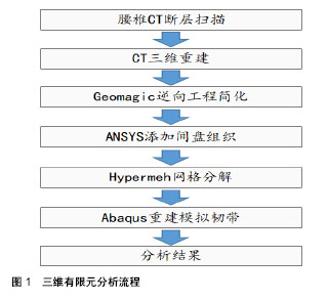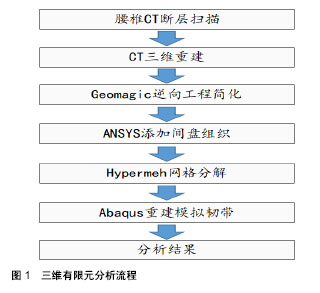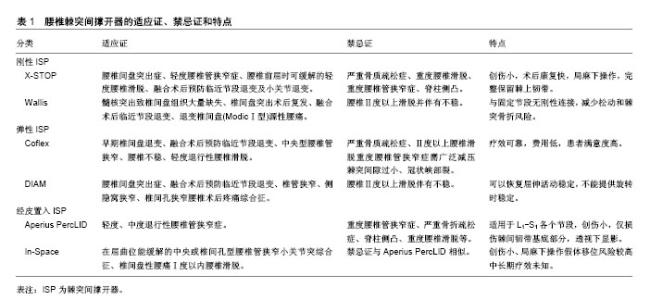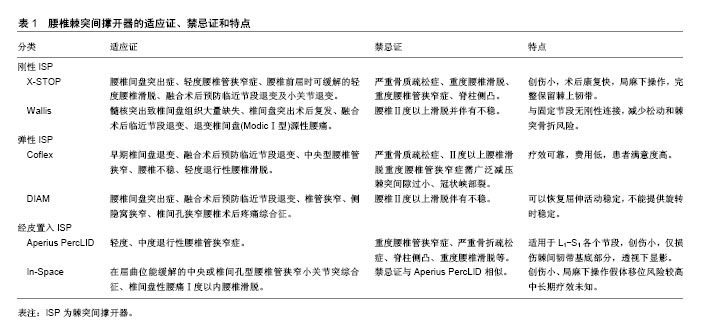Chinese Journal of Tissue Engineering Research ›› 2018, Vol. 22 ›› Issue (31): 5041-5047.doi: 10.3969/j.issn.2095-4344.0568
Previous Articles Next Articles
Characteristics and clinical applicability of lumbar interspinous spacer
Wang Bao-dong, Lu Jun-feng, Cao Yang
- First Affiliated Hospital of Harbin Medical University, Harbin 150001, Heilongjiang Province, China
-
Online:2018-11-08Published:2018-11-08 -
Contact:Cao Yang, MD, Chief physician, First Affiliated Hospital of Harbin Medical University, Harbin 150001, Heilongjiang Province, China -
About author:Wang Bao-dong, Master candidate, First Affiliated Hospital of Harbin Medical University, Harbin 150001, Heilongjiang Province, China -
Supported by:a grant from the Harbin Science and Technology Bureau, No. 2013AA3BS016
CLC Number:
Cite this article
Wang Bao-dong, Lu Jun-feng, Cao Yang. Characteristics and clinical applicability of lumbar interspinous spacer[J]. Chinese Journal of Tissue Engineering Research, 2018, 22(31): 5041-5047.
share this article

2.1 腰椎ISP的生物力学特点及弊端 2.1.1 对置入节段及其邻近节段的活动度影响小 在Lindsey等[4]进行的一项尸体标本体外实验中,X-STOP的置入节段屈伸运动范围显著减小,而其他方向活动度不受影响。Chen等[5]将椎间辅助运动装置和一种新型ISP的虚拟模型置入L3-4节段并应用三维有限元软件分析,正常腰椎置入椎间辅助运动装置和新型ISP后,L3-4节段前屈和后伸活动度均小于正常的50%,侧旋、侧弯时腰椎活动度没有明显变化,其邻近节段各方向活动度也无明显变化。不难看出,ISP装置主要限制置入节段的后伸运动,不增加其他方向及邻近节段的活动度。但也有不同的研究结果出现,反映出ISP各系统存在的生物力学弊端。Ilharreborde等[6]2011年对尸体标本L3/4置入Wallis系统结果显示,置入节段屈伸活动度减少13.8%,而左右侧屈和轴向旋转活动度分别增加6.2%和0.4%,可能增加邻近节段退变的风险,此研究说明ISP装置虽然限制了置入节段的屈伸活动,但增加了样本在侧弯和轴向旋转时的活动范围,导致邻近节段退行性变的风险增加。 从以上的研究中得知,腰椎ISP主要减小置入节段屈伸方向的活动度,其弊端在于不能很好的限制脊柱的侧弯及侧旋运动。 2.1.2 增加置入节段椎管面积及椎间孔高度 Richards等[7]研究了X-STOP置入后屈伸活动时置入节段椎管和椎间孔大小的变化,与非置入组相比,置入组于后伸位时椎管面积增加18%,椎管直径增加10%,椎间孔面积增加约25%,椎间孔宽度增加41%。Siddiqui等[8]通过MRI影像学的研究,分析比较了置入X-STOP后不同体位的情况,发现术后椎间孔及椎管面积显著增加,在后伸体位变化最明显。以上2组研究说明X-STOP置入后可预防置入节段后伸时椎管和椎间孔狭窄,狭窄程度得到了纠正。Hirsch等[9]对In-Space、X-STOP、Wallis和DIAM 4种装置分别置入同一腰椎节段,通过尸体生物力学研究发现4种ISP均增加了后伸位置入节段椎间孔面积,其中Wallis和DIAM仅在过伸位时起到撑开椎间孔作用,而X-STOP和In-Space对包括中立位和过屈位在内的6个运动方向均有作用。但X-STOP和DIAM系统在后伸位时减小了邻近下位节段椎间孔的大小。 总体来说,ISP能显著增加过伸位时椎管面积和椎间孔大小,有些撑开器无论体位如何均对置入节段椎管和椎间孔有一定程度的撑开效果,对于缓解腰椎管狭窄等疾病导致神经受压的根性症状大有裨益。 2.1.3 减小置入节段椎间盘及小关节压力 Wilke等[10]通过体外实验比较了Coflex、Wallis、DIAM和X-STOP 4种腰椎ISP对于椎管内压力的影响,发现4种撑开器均能降低后伸位时的椎间盘内压力,而在过屈位、侧向和轴向运动时4种装置对椎间盘内压力无明显影响,说明ISP装置可以减小后伸时置入节段椎间盘压力。Erbulut等[11]应用有限元腰椎模型研究棘突间固定装置对椎间盘压力的影响,结果显示置入后可显著减小责任节段内椎间盘和小关节的负荷,而邻近节段小关节应力增加高达60%,此项研究表明ISP系统虽然降低了责任节段间盘和小关节的压力,但却给邻近节段小关节增加了额外的负荷,为小关节退变埋下了隐患。无独有偶,陈肇辉[12]于2010年通过Coflex三维有限元分析发现,可降低置入节段椎间盘和小关节压力负荷,可使上下邻近节段小关节负荷增加,同时也使Coflex装置本身及相应节段棘突应力负荷升高,警示存在植入物失效和棘突骨折的可能。 由此可知,ISP装置能减小置入节段椎间盘和小关节的负荷,后伸位时尤甚,对于缓解椎间盘源性疼痛有一定作用。但是存在加速邻近节段小关节的退变和棘突骨折及内置物断裂的风险。 通过以上各种研究得知,腰椎ISP生物力学特点研究方法主要有体外尸体标本实验分析方法和三维有限元分析方法等。体外尸体标本实验虽然较为可靠,但易受实验人员的操作、实验方法、仪器精度、实验环境等因素的影响。随着计算机技术的发展,三维有限元分析方法,可以通过临床影像,精确获得人体腰椎解剖参数,通过专业软件计算出最大应力和腰椎活动度等生物力学数值,是体外尸体标本实验方法的有力补充。三维有限元分析流程见图1。"


2.2 腰椎ISP临床应用的价值与争议 目前,腰椎ISP的临床应用越来越多。可以肯定的是,其短、中期取得了良好的临床治疗效果,但是由于缺少长期、大样本的随访研究,有学者对腰椎棘突间装置临床适用性提出了争议,包括临床疗效的质疑、治疗的成本-效益较低、并发症频出等问题。因此要清醒的认识ISP在临床适用性存在的价值与局限性,为广大临床医生提供重要参考。 2.2.1 显著的临床疗效与质疑 Puzzilli等[13]的多中心研究包含了422例选择X-STOP治疗腰椎管狭窄的患者和120例保守治疗患者,术后1年随访,通过对比目测类比评分、苏黎世跛行问卷评分以及CT、MR影像结果:手术组83.5%患者取得满意效果,而保守组为50%,肯定了ISP治疗腰椎管狭窄的有效性。Pan等[14]对50例应用第2代Wallis系统治疗腰椎退行性疾病患者的术后疗效进行回顾性研究。术后3,12,24个月的日本骨科学会评分均显著高于术前的12分;术后3,12,24个月的Oswestry功能障碍指数均显著低于术前的13%,证明二代Wallis系统对腰椎退行性疾病的治疗有显著疗效。Nunley等[15]的研究中,随访了88例应用Superion系统治疗的腰椎管狭窄的患者,随访时间5年,较术前比较,苏黎世跛行问卷症状严重程度改善率75%,身体功能改善率81%,患者满意率90%,Oswestry功能障碍指数改善率65%,腿部和背部疼痛目测类比评分的成功率分别为80%和65%,75%的患者在5年内无再手术、翻修或其他治疗。Davis等[16]进行了一项多中心前瞻性随机对照研究,比较Coflex系统与脊柱后外侧融合这2种方式治疗伴有椎管狭窄的轻度脊柱滑脱的疗效,Coflex组有62.8%的患者实现了FDA所谓“全面成功”,即Oswestry功能障碍指数、腰背部目测类比评分、下肢目测类比评分以及苏黎世跛行问卷评分均有明显改善,而且Coflex 组患者的手术时间、估计失血量、住院时间均显著少于融合组患者。 根据以上临床证据分析,各种ISP装置在短、中期随访中均具有良好的临床疗效。但也有一些临床疗效不佳的报道,Meyer等[17]对163例伴有神经源性间歇性跛行的腰腰椎管狭窄症的患者进行了多中心、随机、对照试研究,163例患者分别接受经皮Aperius PercLID系统治疗(ISP组)和独立减压手术治疗,前者12个月和24个月后再手术率分别为29%和26%,而独立减压手术组患者仅为6%和8%。Bohm等[18]报道了6例接受ISP治疗的Ⅰ度腰椎滑脱症的患者,平均随访9.2个月后发现4例接受X-STOP治疗和2例接受Aspen治疗的患者分别在2个月后出现不同程度的神经症状复发,更有甚者出现症状恶化,症状复发率在此项报道中达到了100%,虽然是个例,但是如此高的复发率仍值得关注。ISP系统不仅存在以上弊端,有研究证明ISP装置的临床效果不一定优于保守治疗和传统减压术[19-20]。 总体来说,ISP在手术时间、术中出血量、住院时间等方面比传统术式更胜一筹。但复发率及翻修率高、临床疗效不确切等弊端使其临床适用性受到质疑。 2.2.2 临床成本-效益评价褒贬不一 Yaghoubi等[21]对刚性ISP代表(X-STOP)、弹性ISP代表(Cofex)与椎板切除术治疗腰椎管狭窄患者进行了成本-效益比较,研究发现椎板切除术、X-STOP和COFLEX的平均成本分别为3 019美元、2 022美元和2 566美元。X-STOP和COFLEX与椎板切除术增量成本效益比分别为665.9美元和780.7美元,充分说明了刚性ISP(X-STOP)和弹性ISP(Coflex)是比椎板切除术更具成本效益的治疗策略。Schmier等[22]研究也认为Coflex手术相比于传统融合术,不仅费用更少,且费用性价比更高。以上2人的研究说明,ISP系统相比传统融合术来说成本效益更具有价值。然而,不同的研究结果同样值得关注。在Lønne等[23]对96例腰椎管狭窄症患者行X-STOP微创减压术的成本-效果分析得到了很好的说明,结果明确显示,1年症状减轻需比传统减压术额外花费25 700欧元。Van den Akker-van Marle等[24]和Patil等[25]也得出了一致的结论:与传统减压术相比,ISP治疗的成本-效益性价比更低。 以上研究说明,ISP治疗的成本-效益低虽然使其临床适用性受限,但对于传统减压术来说仍具有积极的优势。 2.2.3 临床应用并发症 随着术者手术水平的提高及围手术期护理技术的不断完善,腰椎ISP治疗腰椎退行性疾病的并发症有所降低,但仍是困扰临床医生永恒的难题。各型ISP均不可避免的将腰椎生物力线后移,导致棘突承担了额外的腰椎负荷量,再加上频繁屈伸运动,棘突应力性骨折成为临床最常见的并发症。Gazzeri等[26]对10年间1 108例不同腰椎疾病患者进行回顾性分析后发现,棘突骨折在X-STOP系统、Viking系统、DIAM系统、Wallis等系统中发生例数分别为16例、5例、2例、1例。有时候X射线片难以发现的隐匿性棘突骨折,必要时需借助CT等辅助检查手段明确诊断。Kim等[27]报道了38例患者置入X-STOP术后的CT随访结果,6个月内11例(28.9%)发生了棘突隐匿性骨折,11例患者的X射线片上均未发现骨折。因此,作者认为术后随访只行X射线检查,可能会遗漏隐匿性棘突骨折的诊断。除棘突骨折外,假体松动、脱出或断裂同样值得关注。Xu等[28]进行的回顾性分析显示,131例接受减压手术和Coflex系统治疗退行性腰椎疾病的患者均不同程度的并发Coflex松动(1例)和固定翼断裂(1例)。Barbagallo等[29]报道置入X-STOP后随访23个月,有3例患者术后立即发生了装置脱出,另有1例患者术后6周随访发现装置脱出。此外,一些少见并发症同样不容忽视。Stefanovic等[30]和Epstein[31]报道几例腰椎滑脱症等不同腰椎病变患者分别接受DIAM系统和X-STOP系统治疗,随访发现并发棘突骨溶解、筋膜下脓肿及术后双足下垂。另外,还有Wallis系统术后并发双侧关节突关节应力性骨折以及Coflex术后因异位骨化压迫硬膜囊的报道[32-33]。 不难看出,临床并发症的出现使ISP的临床适用性大打折扣,总结其临床适用性受限的原因迫在眉睫。 2.3 腰椎ISP临床适用性受限原因分析 2.3.1 手术适应证和禁忌证掌握不准确 不同种类的棘突间装置生物力学特性各异,各个ISP系统的手术适应证和禁忌证也不尽相同。Tamburrelli等[34]对1例严重腰椎管狭窄的患者行Superion治疗,术后该患者立即出现了脊柱侧凸,后行置入物移除与椎扳切除术后症状缓解。Postacchini等[35]对36例Aperius PercLID置入患者与 35 例传统减压术的严重椎管狭窄症患者进行对比,结果发现行腰椎管减压组比Aperius PercLID组临床疗效更佳。从以上2人的结论推断出ISP装置可能并不适用于重度椎管狭窄患者。Verhoof等[36]对12例Ⅱ度腰椎滑脱导致的腰椎管狭窄症患者应用X-STOP治疗,随访30.3个月后发现患者腰椎滑脱程度没有任何改善。由此可知,ISP同样不适用于重度腰椎滑脱患者的治疗。Rolfe等[37]对116例无脊柱侧凸、41例轻度脊柱侧凸(Cobb角11°-25°)和22例伴严重脊柱侧凸(Cobb 角> 26°)的腰椎管狭窄症患者行X-STOP置入术,严重脊柱侧凸的腰椎管狭窄患者Oswestry功能障碍指数改善> 15%仅占18%。因此X-STOP系统并不适用于脊柱侧凸> 25°的腰椎管狭窄患者。结合国内外最新文献报道及作者单位在应用ISP治疗过程中取得的经验,腰椎ISP置入的禁忌证大致可总结为:严重的腰椎管狭窄症、脊柱侧凸>25°、Ⅱ度以上腰椎滑脱、严重骨质疏松症、置入部位感染或者全身感染不能耐受手术。此外,ISP装置在设计结构上存在差异,其临床适应证也不尽相同。ISP装置主要可分为静态系统和动态系统。静态系统在设计结构上没有张力带,无法影响脊柱的屈曲运动,但极大地限制了责任节段的后伸活动,这种系统主要用于扩大椎间隙,拉伸后方黄韧带,扩大中央管和椎间孔的面积,起到间接减压神经结构的作用;而动态系统的设计主要是为了减少责任节段的活动度,以恢复不稳定退化节段腰椎刚度。因此,结合以上2种系统的生物力学特点以及不同腰椎疾患病因和治疗机制,ISP一般适应证可归纳为:轻度腰椎管狭窄症、腰椎间盘突出症(初发或复发型)、轻度腰椎滑脱症、融合节段的相邻节段(单节段融合+上位节段棘突间撑开装置即Topping-off手术)。主要ISP系统的适应证、禁忌证和特点见表1。 严格把握ISP装置的临床适应证及禁忌证,依据不同疾病特点和患者自身特性,选择合适的ISP装置施行个体化治疗,可有效降低术后并发症发生率,显著提高ISP的临床治愈率。 2.3.2 术中操作不规范,手术难度大 术者术中规范操作及丰富的经验对改善临床疗效、降低并发症率至关重要。术中操作时腰椎棘突间装置原则上应置入棘突基底部靠近关节突关节的部位,置入过深可能损伤脊髓、神经根的同时,也会增加相邻节段运动范围,增加邻近节段退变的风险;位置太浅会造成装置移位、脱出、感染等并发症等。祖丹等[38]在研究中指出,Coflex的U形顶端与硬脊膜的距离≤5 mm时,上下邻近节段在前屈、后伸、左右侧弯、左右侧旋6个方向运动范围较完整状态无明显增加,且置入深度5 mm组较深入深度0 mm组的上下邻近节段运动范围与完整组更为接近。除了要规范术中操作,更要精确掌握置入深度,Coflex应放置于腰椎椎板间而不是棘突间就值得关注。因此,不绝对依赖保留棘突,这也允许对责任节段进行必要的减压。棘突的解剖形态特点也是造成手术难度增大的原因。Shaw等[39]对2 955具尸体的腰椎上进行棘突形态学测量,发现L5棘突在高度和解剖长度上相比于L1-L4棘突明显缩短,再加上还具有陡峭的斜坡,在解剖学上可能会导致ISP置入时发生棘突骨折的风险增加,加大了手术难度。 综上,术者规范的术中操作结合理论与实践经验的积累对提高临床疗效,降低并发症率至关重要。 2.3.3 棘突解剖形态存在特异性 并发症的发生与棘突的解剖学形态直接相关,把握好棘突形态的特点不仅能降低并发症率,还有助于完善ISP的设计缺陷。Jang等[40]应用MRI对100例斯坦福大学医疗中心的患者进行扫描,结果发现该100例患者L1-L5棘突高度平均水平远大于国人数据从以上研究可以得知,西方人与国人腰椎棘突解剖特点存在显著差异,以西方人腰椎棘突特点研究设计的ISP无法满足国内患者的需求,需要根据国人的棘突形态进一步改善此类设计,因此外科手术必须遵循个体化原则,根据不同种族、性别、年龄的棘突特点以尽量贴合棘突生理形态,减少棘突骨折为目的来选择合适的ISP装置。而且L5/S1由于棘突的特殊生理解剖结构特点不适合ISP装置的置入[39]。除此之外,还存在棘突间距离减少、小关节突肥大或者上棘突下表面的特殊形状等棘突病理变异,导致撑开器无法置入。 因此,应在掌握棘突的生理特异性的基础上,还需了解棘突一些的病理形态,做到心中有数,进一步保障手术安全顺利的进行。 2.4 腰椎ISP的改进理念与设计 目前ISP只限制于腰椎矢状位的前屈与后伸运动,而对于其他位面的运动限制作用甚少。针对这一生物力学弊端,李照文[41]设计了一种万向棘突间撑开装置,其突出优势为可安装于棘突根部或棘突-椎板间,实现棘突间弹性承载并能万向活动,其内外层金属板联成一体,可通过内层金属板底部的防脱钩钩在棘突根部,防止内层金属板向后滑脱,该装置置入时需切开棘上韧带,切除棘间韧带,牵开上下棘突以获得合适间距,用撑开器插入外层金属板与内层金属板空隙内向外撑开,内植物利用内层金属板本身的弹性回缩固定于棘突上,其外层金属板中部的U形变形结构则位于棘间两侧。该装置既保留了病变节段充分的运动功能,又增加了各方向的力学稳定性,能实现充分万向活动,又具有弹性固定功能。 刘铁龙等[42]的理念为ISP置入责任节段后增加了更多的运动体面,解除了目前该装置生物力学弊端的限制。而对于腰椎后路撑开小关节融合系统而言,其不仅能很好的提供脊柱的各方向运动,还能降低邻近节段退变的风险。该系统的特点在于结合棘突间撑开的同时进行关节突关节的固定,既能够通过棘突间撑开扩大椎管面积,又能够通过棘突间的支撑增强小关节螺钉的生物力学强度,该系统还能够覆盖包被小关节,充填棘突间空隙,为该运动节段提供更好的稳定性和更广泛的接触面积,能够避免假体移位、脱出或断裂的发生。 以上2种撑开器主要是针对现有的ISP存在的生物力学问题进行改进,还可以从其材料方面进行改进。比如可以将X-STOP与棘突接触部分聚醚醚酮材料更换为橡胶中嵌入多层钛合金镂空或镍钛合金丝编织的网状支撑薄板,外层橡胶避免了棘突骨折的可能,具有一定的韧性,中间的钛合金板起到支撑作用,保持了撑开了的刚度。 以上新型棘突间撑开系统的研发,为目前ISP的改进提供了新的理念和设计,但目前国内微创动棘突间撑开装置大多停留在理论与设计阶段,仍需进一步的生物载荷分析与动物实验以完善产品。 "

| [1] Ekman P, Möller H, Shalabi A, et al. A prospective randomised study on the long-term effect of lumbar fusion on adjacent disc degeneration. Eur Spine J. 2009;18(8):1175-1186. [2] Ghobrial GM, Williams KA Jr, Arnold P, et al. Iatrogenic neurologic deficit after lumbar spine surgery: A review. Clin Neurol Neurosurg. 2015;139:76-80. [3] Hong P, Liu Y, Li H. Comparison of the efficacy and safety between interspinous process distraction device and open decompression surgery in treating lumbar spinal stenosis: a meta analysis. J Invest Surg. 2015;28(1):40-49. [4] Lindsey DP, Swanson KE, Fuchs P, et al. The effects of an interspinous implant on the kinematics of the Instrumented and adjacent levels in the lumbar spine. Spine(PhilaPa1976). 2003; 28(19):2192-2197. [5] Chen CS, Shih SL. Biomechanical analysis of a new lumbar interspinous device with optimized topology. Med Biol Eng Comput. 2018. [6] Ilharreborde B, Shaw MN, Berglund LJ, et al. Biomechanical evaluation of posterior lumbar dynamic stabilization: an in vitro comparison between Universal Clamp and Wallis systems. Eur Spine J. 2011;20(2):289-296. [7] Richards JC, Majumdar S, Lindsey DP, et al. The treatment mechanism of an interspinous process implant for lumbar neurogenic intermittent claudication. Spine (Phila Pa 1976).2005; 30(7):744-749. [8] Siddiqui M, Karadimas E, Nicol M, et al. Influence of X-STOP on neural foramina and spinal canal area in spinal stenosis. Spine(Phila Pa 1976). 2006;31(25):2958-2962. [9] Hirsch C, Breque C, Ragot S, et al. Biomechanical study of dynamic changes in L4-L5 foramen surface area in flexion and extension after implantation of four interspinous process devices. Orthop Traumatol Surg Rese. 2015;101(2):215-219. [10] Wilke HJ, Drumm J, Hussler K, et al. Biomechanical effect of different lumbar interspinous implants on flexibility and intradiscal pressure]. Eur Spine J. 2008;17(8):1049-1056. [11] Erbulut DU, Zafarparandeh I, Hassan CR, et al. Determination of the biomechanical effect of an interspinous process device on implanted and adjacent lumbar spinal segments using a hybrid testing protocol: a finite-element study. J Neurosurg Spine. 2015; 23(2):200-208. [12] 陈肇辉.腰椎棘突间撑开装置的三维有限元分析及临床应用研究[D].上海:第二军医大学,2010.[13] Puzzilli F, Gazzeri R, Galarza M, et al. Interspinous spacer decompression (X-STOP) for lumbar spinal stenosis and degenerative disk disease: a multicenter study with a minimum 3-year follow-up. Clin Neurol Neurosurg. 2014;124:166-174. [14] Pan B, Zhang ZJ, Lu YS, et al. Experience with the second-generation Wallis interspinous dynamic stabilization device implanted in degenerative lumbar disease: a case series of 50 patients. Turk Neurosurg. 2014;24(5):713-719. [15] Nunley PD, Patel VV, Orndorff DG, et al. Five-year durability of stand-alone interspinous process decompression for lumbar spinal stenosis. Clin Interv Aging. 2017;12:1409-1417. [16] Davis RJ, Errico TJ, Bae H, et al. Decompression and Coflex interlaminar stabilization compared with de-compression an dinstrumented spinal fusion for spinal stenosis and low-grade degenerative spondylolisthesis: two-year results from the prospective, randomized, multicenter, Food and Drug Administration Investigational Device Exemption trial. Spine (Phila Pa 1976). 2013;8(18):1529-1539. [17] Meyer B, Baranto A, Schils F, et al. Percutaneous Interspinous Spacer vs Decompression in patients with Neurogenic Claudication: An Alternative in Selected Patients? Neurosurgery. 2018;82(5): 621-629. [18] Bohm PE, Anderson KK, Friis EA, et al. Grade 1 spondylolisthesis and interspinous device placement: removal in six patients and analysis of current data. Surg Neurol Int. 2015;6:54. [19] Moojen WA, Arts MP, Bartels RH, et al. Effectiveness of interspinous implant surgery in patients with intermittent neurogenic claudication: a systematic review and meta-analysis. Eur Spine J. 2011;20(10): 1596-1606. [20] Beyer F, Yagdiran A, Neu P, et al. Percutaneous interspinous spacer versus open decompression; a 2-year follow-up of clinical outcome and quality of life. Eur Spine J. 2013;22(9); 2015-2021. [21] Yaghoubi M, Moradi-Lakeh M, Moradi-Joo M, et al. The cost effectiveness of dynamic and static interspinous spacer for lumbar spinal stenosis compared with laminectomy. Med J Islam Repub Iran. 2016;30:339. [22] Schmier JK, Halevi M, Maislin G, et al. Comparative cost effectiveness of Coflex® interlaminar stabilization versus instrumented posterolateral lumbar fusion for the treatment of lumbar spinal stenosis and spondylolisthesis. Clinicoecon Outcomes Res. 2014;6:125-131. [23] Lønne G, Johnsen LG, Aas E, et al. Comparing cost-effectiveness of X-Stop with minimally invasive decompression in lumbar spinal stenosis: a randomized controlled trial. Spine (Phila Pa 1976). 2015;40:514-520. [24] van den Akker-van Marle ME, Moojen WA, Arts MP, et al. Interspinous Process Devices versus Standard Conventional Surgical Decompression for Lumbar Spinal Stenosis: Cost Utility Analysis. Spine J. 2014. [25] Patil CG, Sarmiento JM, Ugiliweneza B, et al. Interspinous device versus laminectomy for lumbar spinal stenosis: a comparative effectiveness study. Spine J. 2014;14:1484-1492. [26] Gazzeri R, Galarza M, Neroni M, et al. Failure Rates and Complications of Interspinous Process Decompression Devices: a European Multicenter Study. Neurosurgery. 2016;63 Suppl 1:166. [27] Kim DH, Tantorski M, Shaw J, et al. Occult spinous process fractures associated with interspinous process spacers. Spine. 2011;36(16):E1080-1085. [28] Xu C, Ni WF, Tian NF, et al. Complications in degenerative lumbar disease treated with a dynamic interspinous spacer (Co?ex). Int Orthop. 2013;37(11):2199-2204. [29] Barbagallo GM, Olindo G, Corbino L, et al. Analysis of complications in patients treated with the X -Stop Interspinous Process Decompression System: proposal for a novel anatomic scoring system for patient selection and review of the literature. Neurosurgery. 2009;65(1):111-120. [30] Stefanovic I, Radisavljevic M, Stojanov D. Aseptic intrafascial and extrafascial abscesses 10 years after a 2-level DIAM insertion procedure. J Neurosurg Spine.2015:1-5. [31] Epstein NE. X-Stop: foot drop. Spine J. 2009; 9(5):e6-9. [32] Miller JD, Miller MC, Lucas MG. Erosion of the spinous process: a potential cause of interspinous process spacer failure. J Neurosurg Spine. 2010;12(2):210-213. [33] Maida G, Marcati E, Sarubbo S. Heterotopic ossification in vertebral interlaminar/interspinous instrumentation: report of a case. Case Rep Surg. 2012;2012:970642. [34] Tamburrelli FC, Proietti L, Logroscino CA. Critical analysis of lumbar interspinous devices failures: a retrospective study. Eur Spine J. 2011;20(Suppl 1):S27-35. [35] Postacchini R, Ferrari E, Cinotti G, et al. Aperius interspinous implant versus open surgical decompression in lumbar spinal stenosis. Spine J. 2011;11(10):933-939. [36] Verhoof OJ, Bron JL, Wapstra FH, et al. High failure rate of the interspinousdistraction device (X-Stop) for the treatment of lumbar spinal stenosis caused by degenerative spondylolisthesis. Eur Spine J. 2008;17(2):188-192. [37] Rolfe KW, Zucherman JF, Kondrashov DG, et al. Scoliosis and interspinous decompression with the X-STOP: prospective minimum 1-year outcomes in lumbar spinal stenosis. Spine J. 2010;10(11):972-978. [38] 祖丹,海涌,云才,等.腰椎棘突间动态稳定装置 Coflex 不同置入深度对相邻节段运动范围影响的生物力学研究[J].中国脊柱脊髓杂志, 2014,24(10):933-937.[39] Shaw JD, Shaw DL, Cooperman DR, et al. Characterization of lumbar spinous process morphology: a cadaveric study of 2, 955 human lumbar vertebrae. Spine J. 2015;15(7):1645-1652. [40] Jang D, Park S. A morphometric study of the lumbar spinous process in 100 standford university medical center patients. Korean Neurosurg Soc. 2014;55(5):261-266. [41] 李照文.一种新型脊柱动态内固定系统的理论验证[J].中国组织工程研究,2014,18(4):619-624.[42] 刘铁龙,王静.腰椎后路撑开小关节融合系统、医疗器械的制作方法及融合体:中国,107550608[P].2018-01-09. |
| [1] | Xu Feng, Kang Hui, Wei Tanjun, Xi Jintao. Biomechanical analysis of different fixation methods of pedicle screws for thoracolumbar fracture [J]. Chinese Journal of Tissue Engineering Research, 2021, 25(9): 1313-1317. |
| [2] | Zhang Tongtong, Wang Zhonghua, Wen Jie, Song Yuxin, Liu Lin. Application of three-dimensional printing model in surgical resection and reconstruction of cervical tumor [J]. Chinese Journal of Tissue Engineering Research, 2021, 25(9): 1335-1339. |
| [3] | Chen Xinmin, Li Wenbiao, Xiong Kaikai, Xiong Xiaoyan, Zheng Liqin, Li Musheng, Zheng Yongze, Lin Ziling. Type A3.3 femoral intertrochanteric fracture with augmented proximal femoral nail anti-rotation in the elderly: finite element analysis of the optimal amount of bone cement [J]. Chinese Journal of Tissue Engineering Research, 2021, 25(9): 1404-1409. |
| [4] | Zhou Jihui, Li Xinzhi, Zhou You, Huang Wei, Chen Wenyao. Multiple problems in the selection of implants for patellar fracture [J]. Chinese Journal of Tissue Engineering Research, 2021, 25(9): 1440-1445. |
| [5] | Zeng Yanhua, Hao Yanlei. In vitro culture and purification of Schwann cells: a systematic review [J]. Chinese Journal of Tissue Engineering Research, 2021, 25(7): 1135-1141. |
| [6] | Xu Yulin, Shen Shi, Zhuo Naiqiang, Yang Huilin, Yang Chao, Li Yang, Zhao Heng, Zhao Lu. Biomechanical comparison of three different plate fixation methods for acetabular posterior column fractures in standing and sitting positions [J]. Chinese Journal of Tissue Engineering Research, 2021, 25(6): 826-830. |
| [7] | Cai Qunbin, Zou Xia, Hu Jiantao, Chen Xinmin, Zheng Liqin, Huang Peizhen, Lin Ziling, Jiang Ziwei. Relationship between tip-apex distance and stability of intertrochanteric femoral fractures with proximal femoral anti-rotation nail: a finite element analysis [J]. Chinese Journal of Tissue Engineering Research, 2021, 25(6): 831-836. |
| [8] | Song Chengjie, Chang Hengrui, Shi Mingxin, Meng Xianzhong. Research progress in biomechanical stability of lateral lumbar interbody fusion [J]. Chinese Journal of Tissue Engineering Research, 2021, 25(6): 923-928. |
| [9] | Xie Chongxin, Zhang Lei. Comparison of knee degeneration after anterior cruciate ligament reconstruction with or without remnant preservation [J]. Chinese Journal of Tissue Engineering Research, 2021, 25(5): 735-740. |
| [10] | Xu Dongzi, Zhang Ting, Ouyang Zhaolian. The global competitive situation of cardiac tissue engineering based on patent analysis [J]. Chinese Journal of Tissue Engineering Research, 2021, 25(5): 807-812. |
| [11] | Wu Zijian, Hu Zhaoduan, Xie Youqiong, Wang Feng, Li Jia, Li Bocun, Cai Guowei, Peng Rui. Three-dimensional printing technology and bone tissue engineering research: literature metrology and visual analysis of research hotspots [J]. Chinese Journal of Tissue Engineering Research, 2021, 25(4): 564-569. |
| [12] | Chang Wenliao, Zhao Jie, Sun Xiaoliang, Wang Kun, Wu Guofeng, Zhou Jian, Li Shuxiang, Sun Han. Material selection, theoretical design and biomimetic function of artificial periosteum [J]. Chinese Journal of Tissue Engineering Research, 2021, 25(4): 600-606. |
| [13] | Liu Fei, Cui Yutao, Liu He. Advantages and problems of local antibiotic delivery system in the treatment of osteomyelitis [J]. Chinese Journal of Tissue Engineering Research, 2021, 25(4): 614-620. |
| [14] | Li Xiaozhuang, Duan Hao, Wang Weizhou, Tang Zhihong, Wang Yanghao, He Fei. Application of bone tissue engineering materials in the treatment of bone defect diseases in vivo [J]. Chinese Journal of Tissue Engineering Research, 2021, 25(4): 626-631. |
| [15] | Zhang Zhenkun, Li Zhe, Li Ya, Wang Yingying, Wang Yaping, Zhou Xinkui, Ma Shanshan, Guan Fangxia. Application of alginate based hydrogels/dressings in wound healing: sustained, dynamic and sequential release [J]. Chinese Journal of Tissue Engineering Research, 2021, 25(4): 638-643. |
| Viewed | ||||||
|
Full text |
|
|||||
|
Abstract |
|
|||||